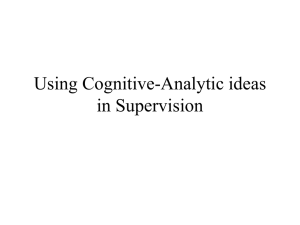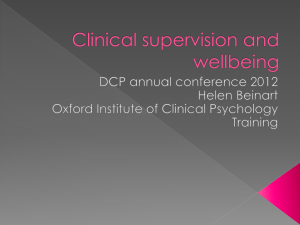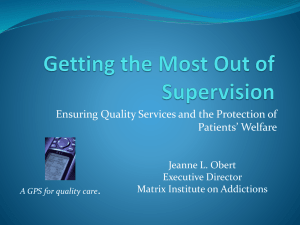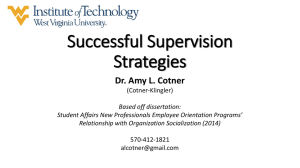Supervision of Novice Counsellors
advertisement
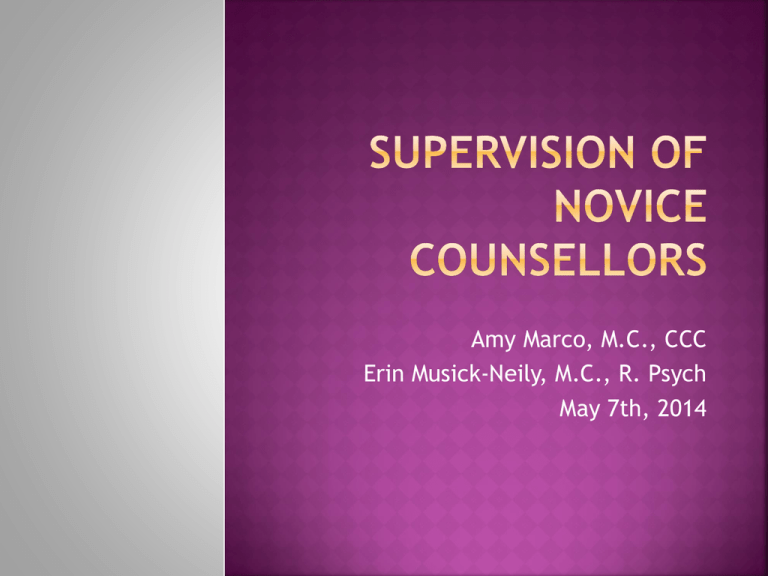
Amy Marco, M.C., CCC Erin Musick-Neily, M.C., R. Psych May 7th, 2014 Who we are Who you are Who in this room has experienced good supervision? What made it good? The experience of good supervision has a lasting impact on us as professionals (Orlinksy, Botermans, & Ronnestad, 2001). It is a relational experience and one that shapes us personally and professionally. Why talk about supervision and new/novice counsellors? Defining supervision Counselling practicums Common presenting issues Developmental model Mirroring process Unique challenges Tips for interns and new counsellors How supervision can help/tips for supervisors Questions 1) 2) Supervision plays a critical role in the preparation of future mental health professionals Two central purposes: To foster the supervisee’s professional development (a supportive and educational function) To ensure client welfare (the supervisor as a gate keeper to the profession) (Bernard & Goodyear; Bornsheuer) ETHICS! Good supervision contributes to the future of the profession and supporting the development of competent and ethical professionals This relates to competency and also public accountability (Rodolfa et al., 2005). Many conceptualizations and models of supervision We are not suggesting a cookie cutter approach but will outline a model that can be applied for supervisors to consider Two main categories of supervision: developmental and administrative Developmental supervision focuses on training/education/mentorship Administrative supervision focuses more on management as a function Canadian Psychological Association; Starr The Mutual Recognition Agreement (2001, p.10) defines supervision as: “A kind of management that involves responsibility for the services provided under one’s supervision and may involve teaching in the context of a relationship focused on developing or enhancing the competence of the person being supervised. Supervision is the preferred vehicle for the integration of practice, theory, and research, with the supervisor as role model” (Canadian Psychological Association, 2001). Bernard & Goodyear (2009) offer the following definition: “Supervision is an intervention provided by a more senior member of the profession to a more junior member or members of the same profession. This relationship: - Is evaluative and hierarchal - Extends over time, and - Has the simultaneous purposes of enhancing the professional functioning of the more junior person(s); monitoring the quality of professional services offered to the clients that she, he or they see; and serving as a gatekeeper for those who are to enter the particular profession.” (p. 7). It is erroneous to assume that all good counsellors make good supervisors. They are unique and distinct processes, that have some shared characteristics. (Scott, Ingram, Vitanza, & Smith, 2000) Specialized training in supervision is recommended in order to engage in the process ethically and competently (Bernard & Goodyear, 2009) Master’s level or Doctorate level of education in a related field (psychology, social work etc.) Require specific number of hours at counselling practicum site Specific direct and indirect client hours Specific number of supervision hours Observation and shadowing Carry own client caseload PD activities and seminars Work with clients is supervised Present own client work Most common: depression, anxiety, stress, academic concerns, transitions/adjustment, relationship issues Less common for practicum students or new counsellors to see: complex trauma, couples/family counselling, Axis II diagnoses Note: sometimes other issues present themselves part-way through counselling, such as trauma, so practicum students do end up working with these issues at times So one role of the supervisor would be to manage these types of issues so that new counsellors are not overwhelmed or taking on presenting concerns they are not equipped to deal with. LEVEL 1 – SUPERVISEE Exhibits high anxiety Exhibits high motivation Is dependent on supervisor Focuses predominately on the self, particularly on performance or technique or following of guidelines (cookbook) Is fearful of evaluation (Falender & Shafranske, 2004, p. 12) LEVEL 1 – SUPERVISOR Should: Be supportive & prescriptive Provide structure and positive feedback Minimal direct confrontation Have the supervisee work with only mildly distressed clients Institute observation and role play Emphasize and encourage conceptualization, skill acquisition and development, self monitoring of skill development, and attention to the client response to intervention (Falender & Shafranske, 2004, p. 12) LEVEL 2 – SUPERVISEE “Trial and tribulation” period Experiences dependency-autonomy conflicts Fluctuates in confidence and motivation Shifts focus to the client with increased empathy Links mood to success with clients Increased understanding of own limitations Uses therapeutic self in interventions Uneven theoretical and conceptual integration Sensitive and anxious re: evaluation (Falender & Shafranske, 2004, p. 12) LEVEL 2 – SUPERVISOR Balances autonomy with support and structure Works to increase autonomy and confidence in the supervisee Introduces and considers countertransference Deals with self, defensiveness, transference, affect and the supervisory relationship Articulates theory and conceptual framing Challenges supervisee to increase self awareness Helps the supervisee identify and understand strengths and weaknesses Accepts de-idealization of him/herself Monitors use of videotaping and live observation Encourages multiple theoretical conceptualizations (Falender & Shafranske, 2004, p. 12) LEVEL 3 – SUPERVISEE “Calm after the storm” Stable motivation Secure in autonomy Focuses on client, self and process Professional identity at the core of his or her treatment Is not disabled by remaining doubts Accepts strengths and weaknesses (high level of insight) Exhibits high empathy and understanding Uses the therapeutic self in interventions Integrates client information, personal responses, theoretical information and empirical information May find it a challenge to be flexible in approach Has accurate empathy Addresses areas of weakness with increased confidence and nondefensiveness (Falender & Shafranske, 2004, p. 13) LEVEL 3 – SUPERVISOR Assesses consistency in performance and works towards integration Emphasizes autonomy and growth Less structure and less intrusive Engages in confrontation Devotes attention to parallel process, countertransference, and the supervisory relationship Encourages self discovery and insight in the supervisee Encourages experimentation and exploration Provides advice re: job searches and professional development (Falender & Shafranske, 2004, p. 12) The process in therapy (between counsellor and client) is mirrored in the supervisory relationship Supervisee awareness of the similarities in both relationships (client/counsellor & supervisor/supervisee) = benefits for therapeutic relationship Increased understanding of client Learn to respond to clients in same/similar way that their supervisor responds to them Russell et al. as cited in Bernard & Goodyear, 2009; Starr, 2014 Transference – can be positive or negative (for example, supervisee views supervisor as more critical than they actually are (from their own internal self-criticalness) or supervisee idealizes supervisor which is important in early stages Other examples: the supervisor becomes the critical parent, the nurturing parent, the dismissive spouse etc. Allphin as cited in Bernard & Goodyear; Lewis as cited in Bernard & Goodyear, 2009 Positive or negative Examples where Intern/Novice Counsellor: Is idealized by client Is viewed as inferior Is viewed as a peer One of the main tasks of supervision is to address countertransference in the supervisory relationship Very strong feelings can arise in supervision for both supervisor and supervisee Sources of countertransference: Supervisee’s interpersonal style, supervisor’s own unresolved personal issues, supervisor’s personality characteristics; nature of learning and teaching Falender & Shafranske, 2004; Omand, 2010 Examples: Viewing client as more intelligent/ capable; Viewing client as peer (feelings of friendship or romantic attraction) Feeling threatened or intimidated by client (academically or otherwise) Viewing client as partner, spouse, friend, etc. Over identification with client (similar age, experiences, schooling) resulting in nontherapeutic discussion Resistance in supervisees may occur when: There is lack of trust in the supervisory relationship Parallel processes interferes Disagreement about supervision tasks and goals Supervisor is too directive Personality clashes/traits Bernard & Goodyear, 2009 Clients with very high intellectual/academic abilities Increased complexity of client issues (i.e. Cairns et al., 2010) Lack of resources—not enough counselling staff to respond to large numbers of clients A mismatch between the type of supervision offered and the type of supervision that is needed (one paint brush) de Rivera (1992) outlines four stages of individual therapy: 1. Commitment -Mutual goals, client motivation, clientcounsellor match 2. Process -Identify problem(s), gain clarity 3. Change -Relapse prevention, applying tools, making and maintaining changes 4. Termination -Develop independence in client, therapeutic gains maintained on own The stages of individual therapy in part mirror the stages of development in supervision Stage 1: Commitment Mirrors Level 1 of IDM Relationship development Mutual goals Stage 2: Process Mirrors Level 2 of IDM Naming of transference and countertransference in supervision Intern/Novice counsellor makes gains Self awareness – role of self in therapeutic process Stages 3 and 4 mirror IDM Level 3 Stage 3: Change Integrating knowledge and skills, increased autonomy and independence, intern more self directed Stage 4: Termination The ending of the internship, moving forward with acquired knowledge and skills Strong working alliance Guidance that matches developmental level Encourage supervisees how to arrive at solutions Assist in managing all experiences, especially uncertainty Don’t provide therapy by proxy Set boundaries -Omand, 2010; Rousmaniere, 2013; Starr, 2014 Haynes et al. (2003) outlines these 10 qualities of inadequate supervision: Lack of interest Lack of availability Rigid approach Lack of knowledge and experience Lack of reliability Irregular feedback Overly critical approach Lack of empathy Lack of organization (no structure) Lack of professional ethics Power (equality vs. differential) Power differential Egalitarian approach Challenge and support Both are needed – it’s a delicate balance Structure (engagement, roles and boundaries) “Supervisees experienced narrowing when they perceived that (a) the feedback was overly critical without being contextualized, (b) the theoretical stance of the supervisor was inflexible, and (c) they were indiscriminately treated as apprentices” (Gazzola & Thériault, 2007) Honesty Read and use resources Patience Self care Consult Openness Personal counselling Boundaries Ethics, ethics, ethics! Be approachable and open Team work approach Don’t supervise from a place of power Keep current Consider additional training specific to supervision Supervise with intention Name transference and counter-transference as issues in supervision Ensure appropriate monitoring throughout (of notes, videos etc.) Encourage self care, balance, outside therapy in supervisees (be mindful of dual roles – be the supervisor, not the supervisee’s counsellor) Erin Musick-Neily, M.C., R. Psych Registered Psychologist – Lethbridge Counselling Services (private practice) counsellorerin@gmail.com Amy Marco, M.C. Counsellor – Alberta Health Services Email: amysmarco@gmail.com Bernard, J.M., & Goodyear, R.K. (2009). Fundamentals of clinical supervision (4th ed.). New Jersey: Pearson. Cairns, S.L., Massfeller, H.F., & Deeth, S.C.(2010). Why do postsecondary students seek counselling? Canadian Journal of Counselling, 44, 34-50. Canadian Psychological Association (2009). Ethical guidelines for supervision in psychology: Teaching, research, practice, and administration. Retrieved from http://www.cpa.ca/cpasite/userfiles/Documents/Su pervisionGuidelinesfinal25Jan09.pdf Casey, D.A. (2007). Students with psychological disabilities in allied health sciences programs: Enhancing access and retention. In J.L. Higbee, D.B. Lundell, I.M. Duranczyk (Eds.). Diversity and the Postsecondary Experience. Retrieved from http://www.cehd.umn.edu/crdeul/docs/monograph/Diversity.pdf de Rivera, J.L.G. (1992). The stages of psychotherapy. European Journal of Psychiatry, 6, 51-58. Falender, C.A. & Shafranske, E.P. (2004). Clinical supervision: A competency-based approach. Washington, DC: American Psychological Association. Gozzala, N., & Thériault, A. (2007). Relational themes in counselling supervision: Broadening and narrowing processes. Canadian Journal of Counselling, 41, 228-243. Haynes, R., Corey, G., & Moulton, P. (2003). Clinical Supervision in the Helping Professions: A Practical Guide. Pacific Grove, CA: Brooks/Cole Thompson. Orlinsky, D. E., Botermans, J. F., & Rønnestad, M. H. (2001). Towards an empirically-grounded model of psychotherapy training: Five thousand therapists rate influences on their development. Australian Psychologist, 36, 139–148. Rodolfa, E., Eisman, E., Rehm, L., Bent, R., Nelson, P., & Ritchie, P. (2005). A cube model for competency development: Implications for Psychology Educations and Regulators. Professional Psychology: Research & Practice, 36, 347-354. Ronnestad, M.H., & Skovholt, T.M. (1993). Supervision of beginning and advanced graduate students of counseling and psychotherapy. Journal of Counseling and Development, 71, 396-405. Scott, K. J., Ingram, K. M., Vitanza, S. A., & Smith, N. G. (2000). Training in supervision: A survey of current practices. Counseling Psychologist, 28, 403–422.
